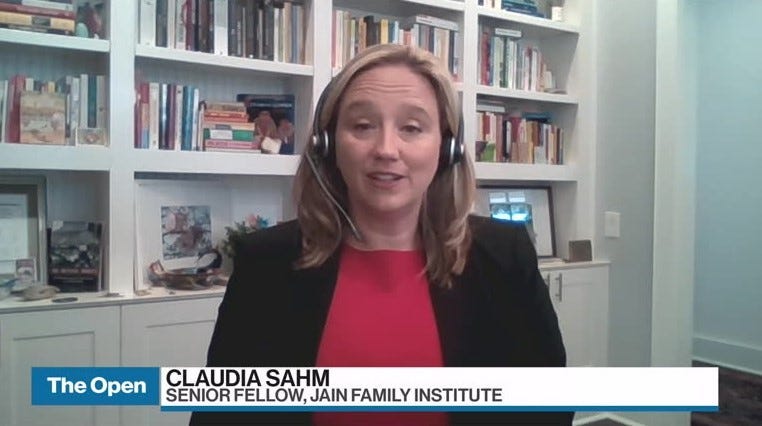As we approach the release of new unemployment figures this Friday, economists are closely watching various indicators of economic health. The latest Wall Street Journal survey of economists suggests a relatively low risk of recession, with the average probability of a recession in the next 12 months estimated at only 28% as of July 2024. However, an intriguing question arises: Could the Sahm Rule, a reliable recession indicator, be on the verge of triggering and potentially surprise economic analysts?
The latest data shows the Sahm Rule Recession Indicator at 0.43, just shy of the 0.50 threshold that would signal a recession. This proximity to the trigger point raises the possibility of a disconnect between economist predictions and what this particular indicator might soon reveal. In this post, we'll explore the original Sahm Rule, its Canadian adaptation, and how investors might approach their strategies during periods of economic uncertainty, especially when different economic signals appear to be in tension.
The Original Sahm Rule: A Recession's Early Warning System
Developed by economist Claudia Sahm in 2019, the Sahm Rule is a reliable indicator for identifying the start of a recession. It states that when the three-month moving average of the national unemployment rate rises by 0.50 percentage points or more relative to its low during the previous 12 months, the economy has entered or is about to enter a recession.
This rule has accurately signaled the onset of every recession since the 1970s, providing policymakers and economists with a valuable tool for early detection of economic downturns. As we await the latest unemployment figures, many will be watching to see if the Sahm Rule is triggered, potentially signaling the start of a new recessionary period in the US.
The latest data from June 2024 shows the Sahm Rule Recession Indicator at 0.43, just below the 0.50 threshold that would signal a recession. This suggests we're in a period of economic uncertainty, but not yet in recession territory according to this metric.
The Canadian Sahm Rule: Innovation Across Borders
The Sahm Rule has been adapted for use in Canada, showcasing how economic indicators can be tailored to different national contexts while maintaining their core predictive power. Economic research suggests that a slightly higher trigger of 0.6 percentage points works better for Canada, compared to the 0.5 percentage point threshold used in the United States.
The Canadian Sahm Rule follows the same principle as its U.S. counterpart: It calculates a three-month average of the Canadian monthly unemployment rate to smooth out short-term fluctuations. This average is then compared with its lowest point over the prior 12 months. When the difference exceeds the 0.6 percentage point threshold, it signals that Canada may be entering a recession.
Interestingly, recent economic data indicates that the Canadian Sahm Rule has just been triggered, suggesting that Canada might currently be in a recession. This development has caught the attention of economists and policymakers, as it contrasts with some other economic indicators that have not yet signaled a downturn.
It's worth noting that while the Sahm Rule has proven to be a reliable indicator in both the U.S. and Canada, it's not infallible. In Canada, there's only one recorded "false positive" outside of a recession since the 1970s, occurring in the mid-1990s. This high degree of accuracy, combined with its simplicity and timeliness, makes the Canadian Sahm Rule a valuable tool for economic forecasting and policy planning.
Investing During Recessions: Steady Course or Strategic Shift?
As recession indicators like the Sahm Rule gain attention, many investors wonder if they should adjust their strategies. However, recent discussions in financial circles, including on the Rational Reminder podcast, highlight that the relationship between economic data and stock returns is often messier than most people realize, both in Canada and the United States.
Historical data shows that of the seven economic recessions in Canada since 1957, four actually saw positive stock returns during the recession period. In the US, a similar pattern emerges, with some recessions coinciding with positive stock market performance. This counterintuitive result occurs because stock markets in both countries price assets based on future expectations, while economic data is backward-looking.
Moreover, even if one could predict recession dates accurately in either country, this information might not translate into profitable trading strategies. Research examining US data has found no evidence that yield curve inversions, which are good predictors of economic activity, can help investors avoid poor stock returns.
Importantly for long-term investors in both Canada and the US, three-year and five-year returns following economic peaks have historically been meaningfully positive. This suggests that even if markets decline during a recession, they tend to recover relatively quickly in both countries.
The key takeaway for investors on both sides of the border is that bad economic conditions don't necessarily mean they should change course with their investments. When we hear news about either country entering a recession, it doesn't automatically imply that we should make our portfolios more conservative or move to cash. The complex, adaptive nature of markets in both nations means that widely known information is already reflected in current prices, making it extremely challenging to outperform through market timing based on economic indicators.
Conclusion
As we await the latest unemployment figures and watch for any triggering of the Sahm Rule, it's crucial to remember that economic indicators, while valuable, don't always translate directly into investment strategies. Whether we're looking at the original Sahm Rule, its Canadian adaptation, or considering our investment approach, the key is to maintain a long-term perspective. Economic cycles come and go, but a well-diversified, consistently maintained investment strategy has historically been the most reliable path to long-term financial success.
Sources:
Federal Reserve Economic Data (FRED) - Sahm Rule Recession Indicator - https://fred.stlouisfed.org/series/SAHMREALTIME
Wall Street Journal Economic Forecasting Survey - https://www.wsj.com/economy/economists-say-inflation-would-be-worse-under-trump-than-biden-263bc900?mod=article_inline
Claudia Sahm's original research on the Sahm Rule - https://www.hamiltonproject.org/assets/files/Sahm_web_20190506.pdf
Claudia Sahm - O Canada!
Rational Reminder, Episode 279 - https://rationalreminder.ca/podcast/279






